Ex-Yugoslavian Countries - 25 Years Later
On 2018-02-26 the analysis and visualizations were redone with a newer dataset, which provided the values which were missing in the original article (mostly for 2015, sometimes for 2014). The values for 2016 were added where available.
Yugoslavia (SFRY) was a socialist state in south-eastern Europe, founded in 1945. It was a federation of six socialist republics, in alphabetical order:
- Bosnia and Herzegovina
- Croatia
- Macedonia
- Montenegro
- Serbia
- Slovenia
In this article, we’ll take a look at the development statistics of these countries in the last 25 years, after the Yugoslavian dissolution in ’90s.
The database is available from The World Bank. This is the updated version of dataset available on Kaggle.
Demography
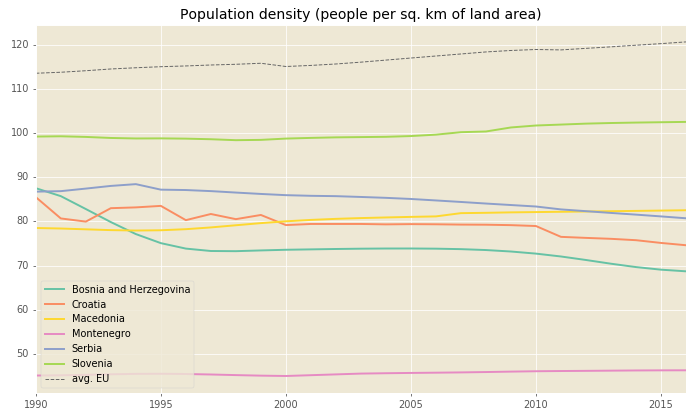
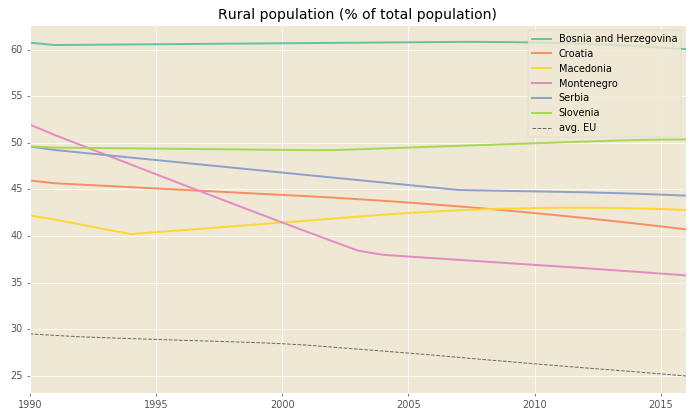
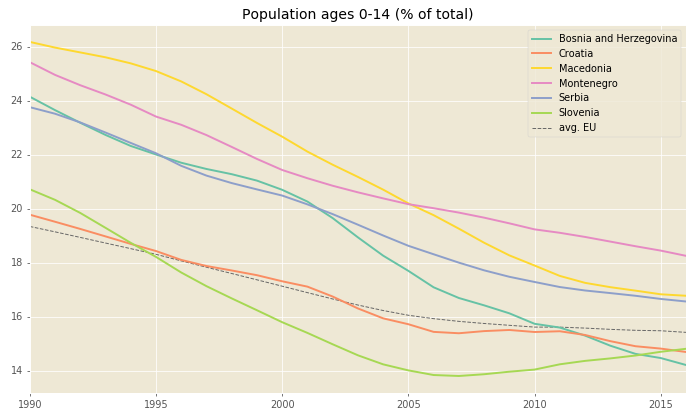
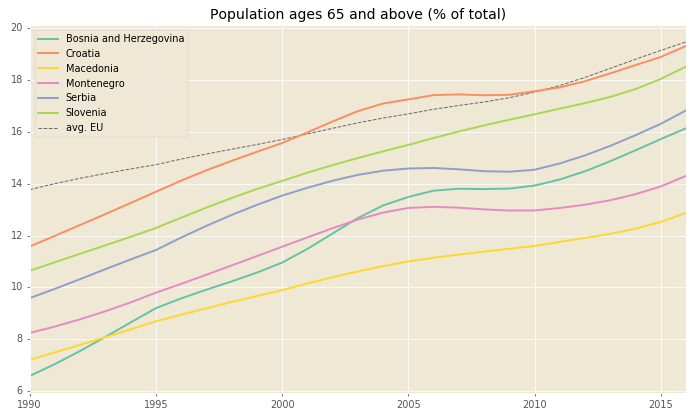
Population density of all countries hasn’t changed much, with the exception of Bosnia in early ’90s, due to war in Bosnia.
The most of population (60 and 50 percent, respectively) of Bosnia and Slovenia live in rural areas. Other countries have slightly lower and slowly decreasing values, but still much higher than EU average.
Last two figures show that all countries are getting older. The situation is the worst in Bosnia, where the number of children aged 14 or less has halved from the value in 1990, while number of people older than 65 more than doubled.
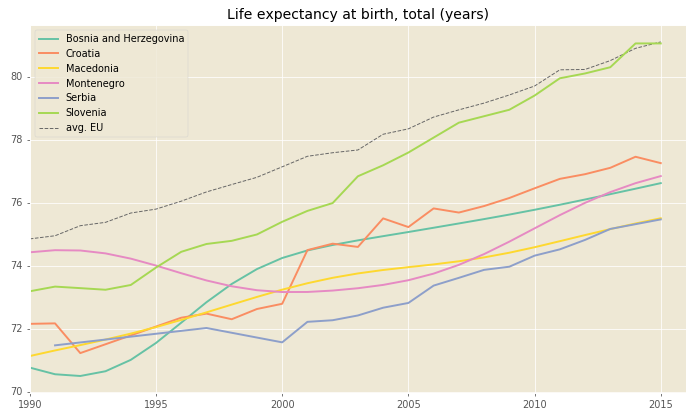
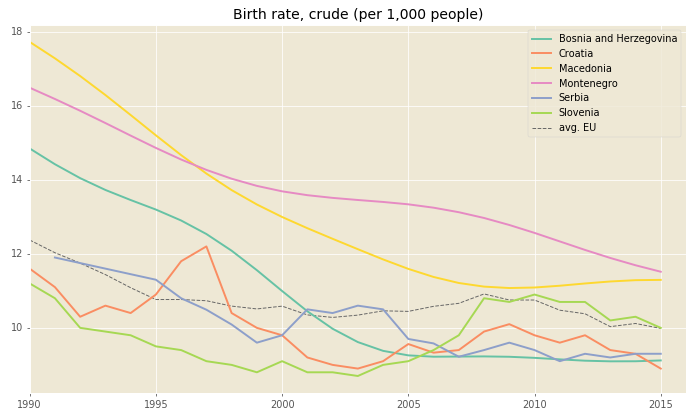
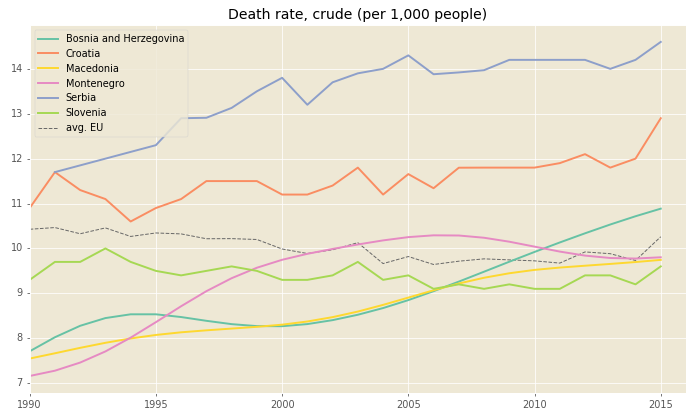
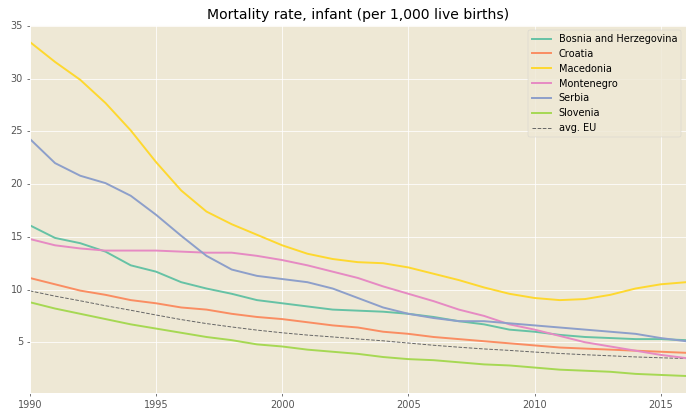
What a difference 25 years make!
The life expectancy in EU for children born in 2015 is 6 years more than for children born in 1990, and infant mortality rate is less than a half of the 1990’s values.
Slovenia has even bigger growth of life expectancy, with 2015’s value the same as EU average.
On the other hand, Montenegro had the highest life expectancy in 1990 of all ex-YU countries, but they had only a minor growth in the last 25 years.
All countries now have lower birth rates than 25 years ago. In just 15 years, birth rates in Bosnia have halved.
Slovenia has managed to keep the same, better than EU average, death rate. In the other countries the death rates have increased in recent years, probably because of generally older population.
Today’s infant mortality rate in all ex-YU countries except Macedonia is close to the EU average. In 1990 only Croatia and Slovenia had values similar to European. The average infant mortality rate of the other four ex-YU countries in 1990 was around 22 per 1000 live births. Lots of progress has been made!
Education

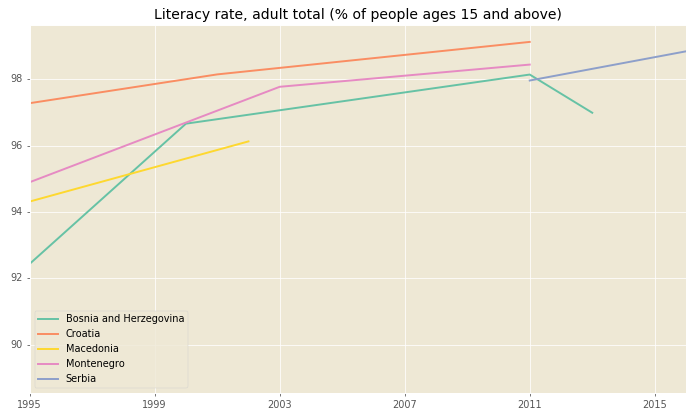
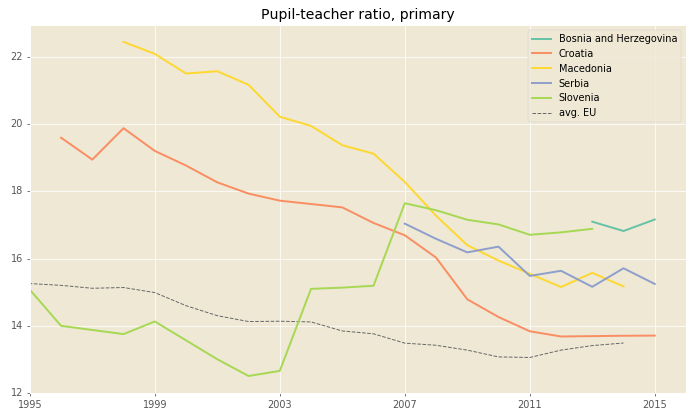
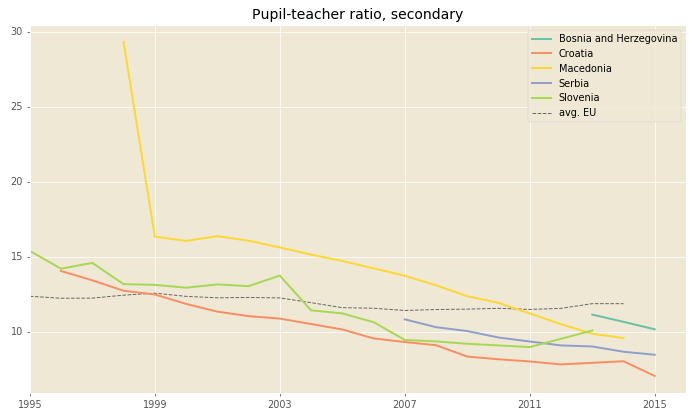
Slovenia is constantly spending on education more than EU average.
Literacy rates have increased in all countries.
Pupil-teacher ratios in both primary and secondary education are on the fall (the exception being Slovenian primary education in 2000s).
In Croatia, in mid 90’s there were 50% more pupils per teacher than there are now.
Economy
GDP per capita
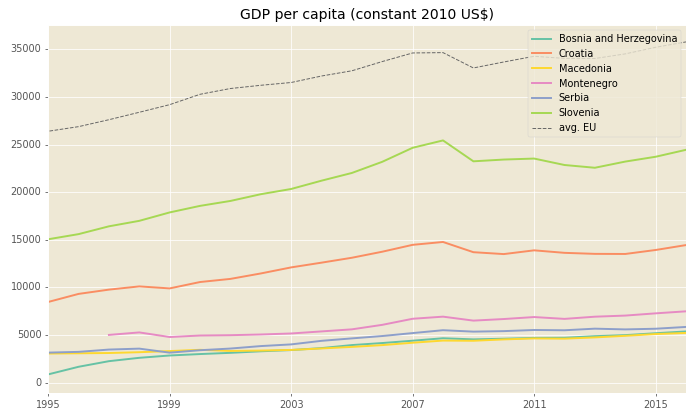
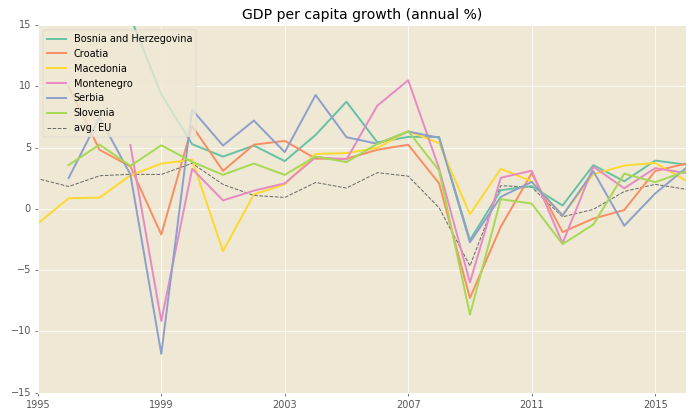
Croatia and especially Slovenia stand out when it comes to GDP per capita, but values are still low compared to the EU average. All other countries have GDP per capita around $5000 (constant 2010 US$).
All countries in early 2000s (before the big economy crisis in 2008) had GDP growth higher than EU average.
The negative spike in 1999 of Serbian and Montenegrin values shows the consequences of Kosovo war.
Unemployment
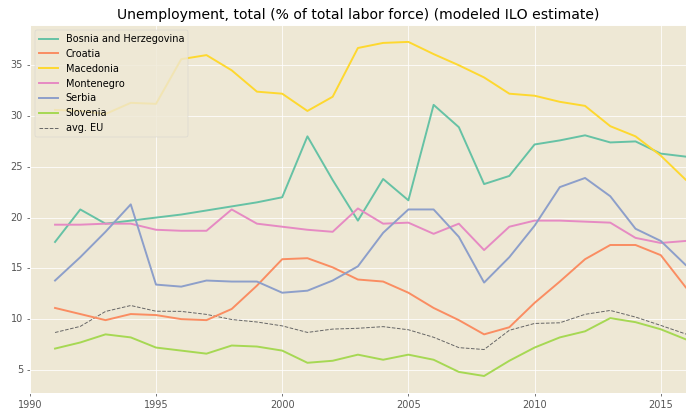
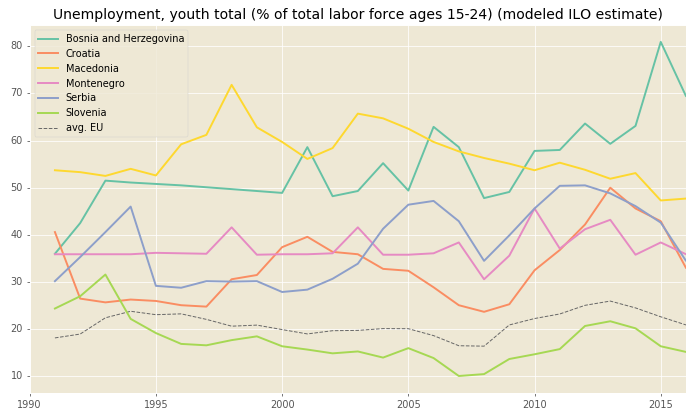
Slovenia has always had lower unemployment than EU average.
Croatia was getting close to EU average in 2009, but after it, as a consequence of the big economy crisis, unemployment rates almost doubled.
Slovenian and Serbian post-2008 unemployment rates show similar characteristics as Croatian.
Other countries weren’t as affected as those three.
Youth unemployment follows a similar pattern as general unemployment.
Internet usage


Slovenia is way ahead of other ex-YU countries when it comes to Internet users and had (relatively speaking) high Internet adoption rates in the late 90’s. One could say that Slovenia is about five years ahead of Bosnia, Serbia, and Montenegro.
Macedonia has about the same rate of Internet users as Croatia, but much lower rate of fixed broadband subscriptions.
Import-Export
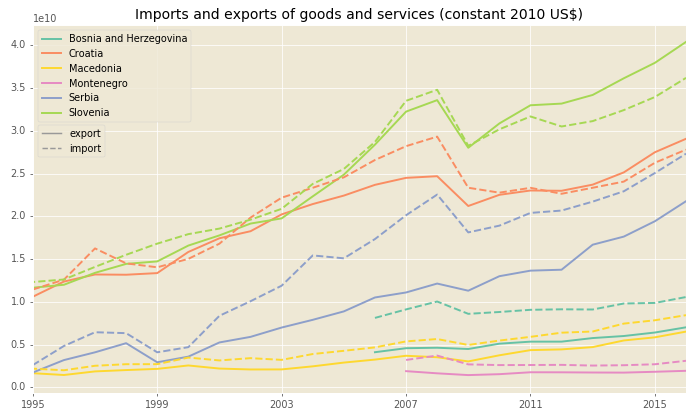
Slovenian economy took a hit in 2008’s economy crisis, but after it Slovenia managed to have significantly higher export than import—something that other countries struggle to do.
Military / research / health
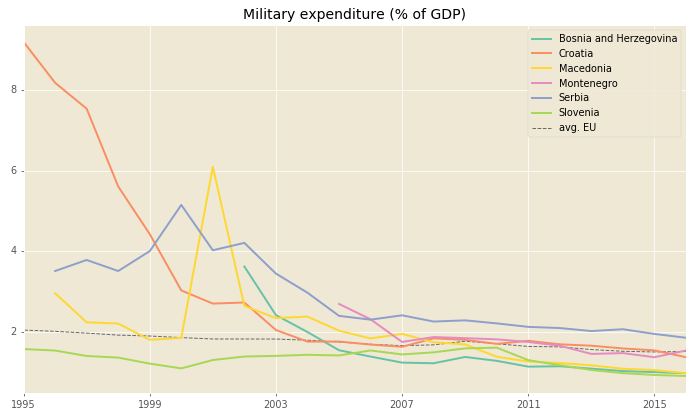

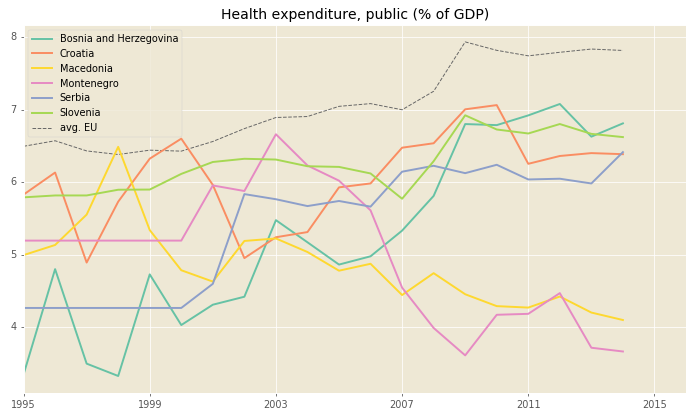
The spike in Macedonian military expenditure is probably due to Albanian insurgency in 2001.
Slovenia from 2007 onward spends more and more on research and development, with slight decline in recent years but still higher than the EU average. Other countries spend less than 1% of their GDP on the R&D.
Health expenditure in all countries is below the EU average.
Conclusion
25 years are a lot in a man’s lifetime, but is it enough time to show changes of slow-living big creatures such as countries?
The data shows that even one year (2008) is enough to shake some ground.
Having that in mind, did six ex-Yugoslavian republics manage to use 25 years constructively?
The biggest progress was made in lowering infant mortality rate, which is now around EU average of 0.4%.
Life expectancy for all countries is now 75+ years (Slovenia 80+ years, EU average), even though health expenditure in all countries is below EU average.
Birth rates have decreased, and all countries got significantly older, both indicators follow trends in the whole Europe.
Literacy rates have increased in all countries, and pupil-teacher ratios in both primary and secondary education are on the fall.
Slovenia is constantly spending on education more than EU average, and in the last five years their expenditure on research and development is also higher than EU average.
Other countries don’t follow the Slovenian example, and are also several years behind Slovenia when it comes to number of Internet users.
Economically, all countries were doing relatively well until 2008.
After 2008, unemployment rates got higher than ever in all countries except Macedonia, which seems to be the least affected by 2008 economic crisis.
After the crisis Slovenia managed to have significantly higher export than import—something that other countries struggle to do.
All countries have made some progress, but there is a room for lot more in the years to come.
Data preparation, analysis, and visualizations were made in Python. Source code is available here.